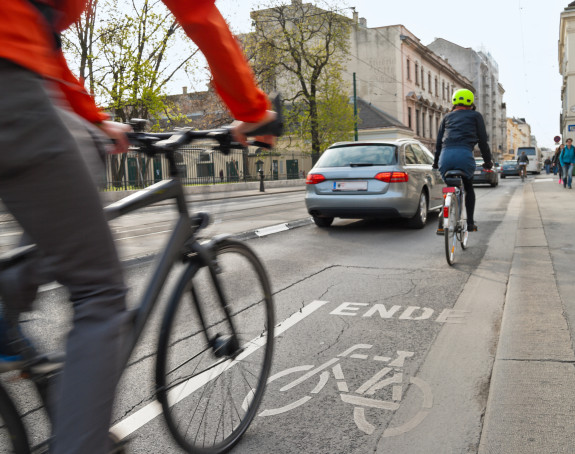
Standstill instead of necessary modernisation of the Traffic Act
The reform of the German Road Traffic Act [Straßenverkehrsgesetz – StVG] and the subordinate German highway code [Straßenverkehrsordnung – StVO] was to be one of the large reform projects of the German Federal Government. It is anchored in the Coalition Agreement that it should be possible for cities and municipalities to consider the “objectives of climate change mitigation and environmental protection, of health and of urban development” when implementing traffic legislation measures in the future. What sounds relatively prosaic here, would have far-reaching consequences in the cities. Some experts in the fields of law and traffic described it as the start of a “paradigm shift” because the StVG forms the basis of the regulations for using public roads and for the control of traffic by local authorities. The municipalities would have gained considerable room for manoeuvre thanks to the amendments. As a result, the municipalities – as the organisations with knowledge of local circumstances – would have been able to shape mobility and control the traffic in ways appropriate to the situation.
However, things turned out differently. The changes to the German Road Traffic Act [Straßenverkehrsgesetz] passed by the Bundestag [lower house] last autumn could not achieve the required majority in the Bundesrat [upper house] in November – despite the draft having gained the unanimous and cross-party approval of all the traffic ministers of the federal states in advance. And with that the planned amendment was stopped for the time being. The municipalities were correspondingly greatly disappointed.
What are the local authorities demanding?
The background is that the municipalities currently operate within an awkward legal framework, which barely allows them to move forward with the necessary and required transport transition locally without lengthy bureaucratic procedures. If the municipalities are to significantly contribute to shaping the traffic transition, achieve the objectives of climate change mitigation and, at the same time, ensure the mobility of people, then they need a legal framework, which eliminates the hitherto existing legal uncertainty and grants them the necessary room for manoeuvre.
Currently, the municipalities’ scope for decision making regarding traffic law ordinances is limited primarily because the traffic laws, as legislation to avert danger, are almost exclusively designed to protect the “safety and ease” of the traffic. In practice, until now it has meant prioritizing motor vehicle travel over all other modes of travel.
Even the municipal initiative “liveable cities through appropriate speed” provides impressive evidence of the lacking room for manoeuvre and the growing pressure to act in the municipalities. Since July 2021, over 1,000 cities, towns, municipalities and districts have been advocating for more freedom in local decision-making. The initiative calls for the Federal Government to create the legal prerequisites so that the municipalities are able to implement 30 km/h zones where they deem them necessary. Currently, such a regulation is limited on main roads and it is only possible after providing proof of a specific danger or in the environment of sensitive establishments, e.g., nurseries or schools. Cynically seen, in many cases an accident needs to happen before a 30 km/h zone is implemented.
Advantages of the reform
With the modernisation of the law, two significant reforms for the municipalities were to be introduced. In the amendments to the StVG, the requirements of “environment protection and climate change mitigation, health protection and urban development” could have been used to justify traffic legislation measures. Following from the amended StVG, the StVO was to state three cases of application in particular, in which the municipalities’ scope of action would have significantly improved: establishing bus lanes, designating pedestrian and cycle zones, and parking management. It would have offered relaxation in particular for the ecomobility network, i.e., local public transport, pedestrian and bicycle traffic, car and bike sharing, car pooling centres, which play an important role both in achieving climate objectives and in the traffic transition on the ground. For many municipalities, the reform proposal did not go far enough, in particular in regard to designating zones for parking management and implementing 30km/h zones. Nevertheless, the planned amendment was a step in the right direction and had above all paved the way for future improvements. The Association of German Cities felt the reform was “not the big hit that the cities had wished for,” but rather a solid first step towards more scope for decision-making in the shaping of mobility.
But how is it possible that a proposed reform failed when it had cross-party approval from all traffic ministers of the federal states, when it was called for by over 1,000 cities, towns, municipalities and districts, also on a cross-party basis, and when it was supported by a multitude of associations and civil society stakeholders? The answer is surely found in party and power politics rather than in the facts and in light of the current traffic policy discourse, it is also not very surprising. The blocking federal states justified the U-turn in the Bundesrat by saying that the objectives of safety and ease in road traffic would be undermined if other protective objectives, such as protecting the environment and climate change mitigation were included in the StVG and StVO. However, this justification proved to be not very logical because the protective purpose of “safety and ease in road traffic” would not have been restricted at all through the amendments to the law.
A missed opportunity?
As it is, the German cities and towns are going through a rough period. The challenges are becoming more diverse and more complex. The traffic transition is just one of them. If the municipalities are to shape and implement the traffic transition locally, it is imperative that they are involved and supported in these demanding tasks. However, the exact opposite is happening with the blocking of the traffic law reform. A chance has (for now?) been missed. Yet, waiting around for the perfect solution, which nevertheless doesn’t exist, doesn’t help, instead it’s best to act pragmatically. Especially in times, when money is short and majorities are harder to organise, the Federal Government can create freedoms, which cost almost nothing but are very useful for the necessary transformation of our traffic system. It is precisely for this reason that the Federal Government should save what can still be saved and do everything in its power to pass the modernisation of the StVG in this legislative period.
To do so, the Bundestag and the Federal Government should call the conciliation committee. It would be a chance to still reach an agreement, however, it would again require votes and majorities in the Bundestag and Bundesrat. And that’s the vicious circle: for as long as there is no clear intention on a federal level to drive this process and ensure legal certainty for a future-orientated traffic policy on the municipal level, the municipalities and the future-orientated design of the traffic system are left with nothing. The traffic transition will then be happening somewhere else.
Vorabveröffentlichung aus dem Difu-Magazin Berichte 1/2024 - difu.de/18379
